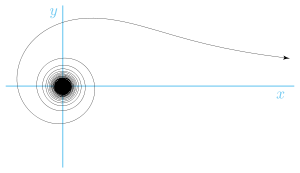Lituus (mathematics)

Branch for positive r
In mathematics, a lituus is a spiral with polar equation
where k is any non-zero constant. Thus, the angle θ is inversely proportional to the square of the radius r.
This spiral, which has two branches depending on the sign of , is asymptotic to the axis. Its points of inflexion are at and .
The curve was named for the ancient Roman lituus by Roger Cotes in a collection of papers entitled Harmonia Mensurarum (1722), which was published six years after his death.
External links
- Hazewinkel, Michiel, ed. (2001) [1994], "Lituus", Encyclopedia of Mathematics, Springer Science+Business Media B.V. / Kluwer Academic Publishers, ISBN 978-1-55608-010-4
- Weisstein, Eric W. "Lituus". MathWorld.
- Interactive example using JSXGraph
- O'Connor, John J.; Robertson, Edmund F., "Lituus", MacTutor History of Mathematics archive, University of St Andrews .
- https://hsm.stackexchange.com/a/3181 on the history of the lituus curve.
| Wikimedia Commons has media related to Lituus (function). |
This article is issued from
Wikipedia.
The text is licensed under Creative Commons - Attribution - Sharealike.
Additional terms may apply for the media files.